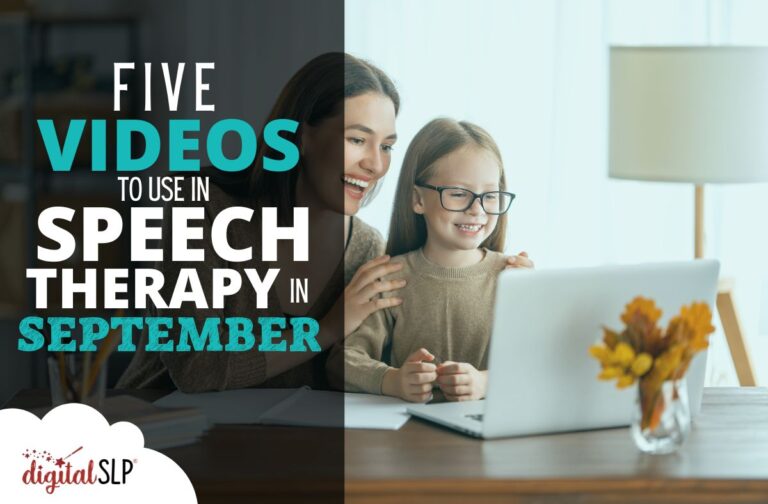July is a great time to embrace a slower pace, with low-prep speech therapy activities that address multiple goals. I hope these new video recommendations help you spend less time planning and more time having fun in the sun!
Just a quick reminder: I watched all of the videos and found them to be worthwhile, but everyone’s needs are different, so please preview any video fully before sharing it with students.
Length: 4 minutes
Ages: 1st–8th grade
July is International Zine Month, honoring these versatile, self-published booklets that can explore any topic. This gentle video features an overview of zines, as well as a simple tutorial. (You may need to supplement with additional instructions.)
Art educator Raymond Yang believes zines (pronounced “ZEENS”) provide “an opportunity for students to serve at the intersection of maker, expert and teacher.” Here are some ideas for how to use them in your sessions:
- Articulation: Students could create zines showcasing tips for the sounds they’re working on. They could also include target words with visual support (drawings, etc.). These would be perfect for carryover and home practice!
- Get to know you: Zine culture is all about honoring identity, so students could make and share zines about their interests. Yang recommends providing prompts to help them generate ideas, e.g., “I am an expert on . . .” “I care a lot about . . .” “I can explain how to . . .” (For more suggestions, see Yang’s helpful article Why Zines Need to Be a Part of Your Curriculum—it even has a Making a Zine brainstorming document!)
- Language: Students could create zines to explain tricky language topics like parts of speech, idioms, or inferences in their own words.
- Sequencing: Students could make “how to” zines related to familiar tasks (or special interests), and then use them to teach each other about their selected topics. Creating a zine about a familiar story could also be a fresh way to work on narrative!
- Extension: Traditionally, distribution is an important part of the zine-making process—they are meant to be shared! But this doesn’t have to involve massive amounts of photocopies (unless you want it to). You could simply invite different clients, students, or groups to exchange zines with each other. You could also create a speech zine library!
Length: 3 minutes
Ages: Preschool–Kindergarten
July is an epic month for fans of frozen treats! It’s National Ice Cream Month, and there’s also National Creative Ice Cream Flavors Day on the 1st, National Strawberry Sundae Day on the 7th, and National Freezer Pop Day on the 8th.
The silly song in this fun video could help your students celebrate one or all of these occasions—and practice many communication skills, including:
- Articulation: The words “do,” “don’t,” and “like” are repeated many times in this video, offering lots of practice opportunities for students working on /d/, /l/, or /k/.
- Basic concepts: As students observe the different foods that appear in this video, they could talk about the shapes and colors that they see. They could also discuss concepts like sweet, salty, and sour!
- Emotions: The video’s animated characters illustrate a variety of emotions with their facial expressions. You could periodically pause the video and ask students how they think the character feels at that moment (and why).
- Questions: Yes/no questions have never been so entertaining, and there are 12 of them in this video, so you can get some good data!
- Extension: If your students mysteriously crave ice cream after watching this video, they could use this energetic tutorial to make their own (with help!). And if they can’t get enough of songs about wild food combos, they may want to check out Do You Like Spaghetti Yogurt?
Length: 10 minutes
Ages: 2nd–6th grade
Friendship is one of life’s greatest gifts, but for the grudge-holding main character in Jory John and Pete Oswald’s clever picture book, it’s a tricky gift to access—until he discovers that repair feels much better than resentment.
This entertaining read-aloud is an ideal choice for the International Day of Friendship on July 30th, and it could be used to target several goal areas, especially:
- Articulation: Students working on /g/ or /r/ will find plenty of practice possibilities (“grateful,” “grumpy,” “grape,” “grandma,” “grandpa,” “grudge,” and “grumble”) in this book!
- Cause and effect: There are numerous clear examples of cause and effect in this book—you may even want to help your students create a diagram.
- Idioms: The Sour Grape (along with all the other titles in The Food Group collection) is an approachable entry point for learning about idioms, with context clues and visual support to help students discern their underlying meanings. Examples include “sour grapes,” “thin skin,” “close knit,” and “clear the air.”
- Parts of speech/vocabulary: There are many juicy adjectives (“tart,” “melodic,” “sublime”), adverbs (“rigorously,” “vigorously,” “prominently”), nouns (“goodwill,” “spectator,” “consideration”), and verbs (“stroll,” “highlight,” “rant”) in this book.
- Extension: Students could explore the activity guide from the publisher, or discuss whether they identify with the grape’s experiences.
Length: 8 minutes
Ages: 3rd–8th grade
This fascinating and reassuring video opens with a quick fact about sharks (they lose 30,000 teeth in a lifetime!), and then dives into answering the burning question referenced in its title.
With this video, students can observe Shark and Ray Awareness Day on July 14th, and also work on:
- Compare and contrast: During the video, students could identify similarities and differences between shark teeth and human fingers (it sounds like a stretch, I know—but it will make sense after you watch the video!). Students could also compare the common public perception of sharks with the facts that are presented in this video, or compare sharks with other sea creatures.
- Discussion/personal narrative: Students could brainstorm additional infamous animal examples, or talk about their own experiences with gossip, bias, and unfairness.
- Predicting: There are several opportunities to pause the video and ask students to make a prediction. For example, you could pause at 3:20 and ask students to predict the reasons why sharks occasionally bite humans.
- Wh-questions: This video includes a vast amount of factual information, making it a prime option for working on comprehension and wh-questions.
- Extension: Students could take a bite out of the activities featured in a shark-themed blog post I shared last summer. Or, they could research what it takes to become an elasmobranchologist.
Length: 4 minutes
Ages: Any! (Some students may need a gentle “Don’t try this at home” reminder.)
Just like sharks, bees are a keystone species, vital for our survival. And, like sharks, they are frequently feared and misunderstood! This video offers students a new perspective and spotlights the dedicated work of an enthusiastic bee rescuer.
Here are some buzzworthy speech therapy activities to pair with this video:
- Describing: Sensory information is everywhere in this video, from buzzing sounds to colorful flowers. Students could describe what they see and hear, and imagine what they might feel and smell if they experienced the elements of this video in real life.
- Fact/opinion: After students watch the video, you could give them a list of short statements (e.g., “Bees are scary,” “Bees are helpful,” “Bees are beautiful,” “Bees are pollinators”) and ask them to discuss which statements are facts and which are opinions.
- Sequencing: Apiarist Hilary Kearney completes several bee colony rescues during this video. Students could talk about the different steps in each rescue (and make inferences about what she might have done before the video began or after it ended).
- Verbs: This video includes a mix of regular and irregular verbs (e.g., “crawl,” “fly,” “bring,” “sting,” “rescue,” “work”), allowing students to practice their past tense skills.
- Extension: Kearney doesn’t just care for bees—she also takes incredible photos of them! Students may want to check out her stunning online galleries. Or, they might be excited to learn more about how to help pollinators!
I hope you have a great time sharing these videos with your students and clients!
If you love using videos in your speech sessions and want weekly recommendations and activity suggestions in your inbox, consider signing up for a Digital SLP membership! This is just one of the many bonuses you receive when you become a paid subscriber.
Click here to learn more.













Recent Comments